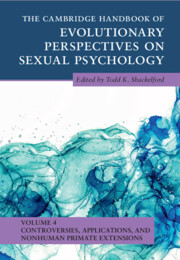Book contents
- The Cambridge Handbook of Evolutionary Perspectives on Sexual Psychology
- The Cambridge Handbook of Evolutionary Perspectives on Sexual Psychology
- Copyright page
- Contents
- Contributors
- Preface
- Part I Controversies and Unresolved Issues
- Part II Applications to Health, Law, and Pornography
- Part III Nonhuman Primate Sexual Behavior
- 14 Chimpanzee Sexual Behavior
- 15 Bonobo Sexual Behavior and Psychology
- 16 Orangutan Sexual Behavior
- 17 Gibbon Evolved Sexual Psychology
- 18 Sexual Behavior in Marmosets in the Context of Cooperative Breeding
- 19 Capuchin Sexual Behavior
- 20 Sexual Behavior in Neanderthals
- Index
- References
19 - Capuchin Sexual Behavior
from Part III - Nonhuman Primate Sexual Behavior
Published online by Cambridge University Press: 30 June 2022
- The Cambridge Handbook of Evolutionary Perspectives on Sexual Psychology
- The Cambridge Handbook of Evolutionary Perspectives on Sexual Psychology
- Copyright page
- Contents
- Contributors
- Preface
- Part I Controversies and Unresolved Issues
- Part II Applications to Health, Law, and Pornography
- Part III Nonhuman Primate Sexual Behavior
- 14 Chimpanzee Sexual Behavior
- 15 Bonobo Sexual Behavior and Psychology
- 16 Orangutan Sexual Behavior
- 17 Gibbon Evolved Sexual Psychology
- 18 Sexual Behavior in Marmosets in the Context of Cooperative Breeding
- 19 Capuchin Sexual Behavior
- 20 Sexual Behavior in Neanderthals
- Index
- References
Summary
The neotropical capuchin monkeys (genera Cebus and Sapajus) have converged with hominins and Pan in several respects, including brain expansion and slow life histories, and they thereby provide an important data point for comparative analyses. Capuchins live in stable, female-philopatric social groups in which alpha males, as preferred mates, sire a disproportionately large share of offspring. Periods of violent upheaval within groups alternate with long periods of social peace and stability, during which an alpha male retains his position with (in Cebus) coalitional support from subordinates against potential usurpers from outside the troop. Males’ “career trajectories” are products of a set of incompletely understood constraints, decisions, and random events. New alpha males often kill the nursing offspring sired by their predecessors, and females respond to this threat by supporting reigning alpha males against rivals from within and outside the group. Long alpha male tenures result in co-residence between alpha males and their adult daughters. Father–daughter inbreeding is almost entirely avoided via selective, cue-based sexual aversion. Sapajus employs an elaborate repertoire of courtship signals.Same-sex sexual interactions are fairly common and may function to negotiate social relationships.
- Type
- Chapter
- Information
- Publisher: Cambridge University PressPrint publication year: 2022



